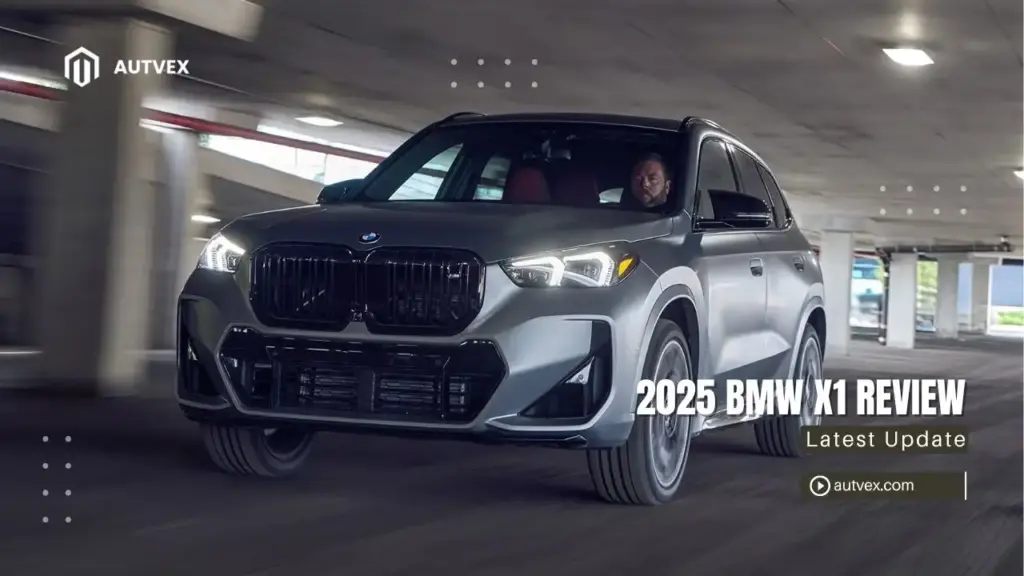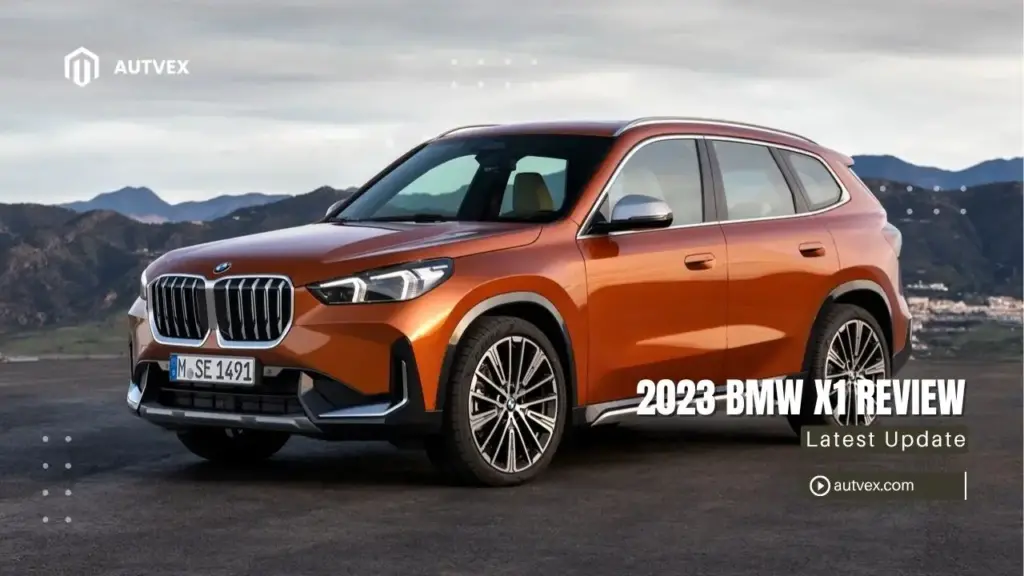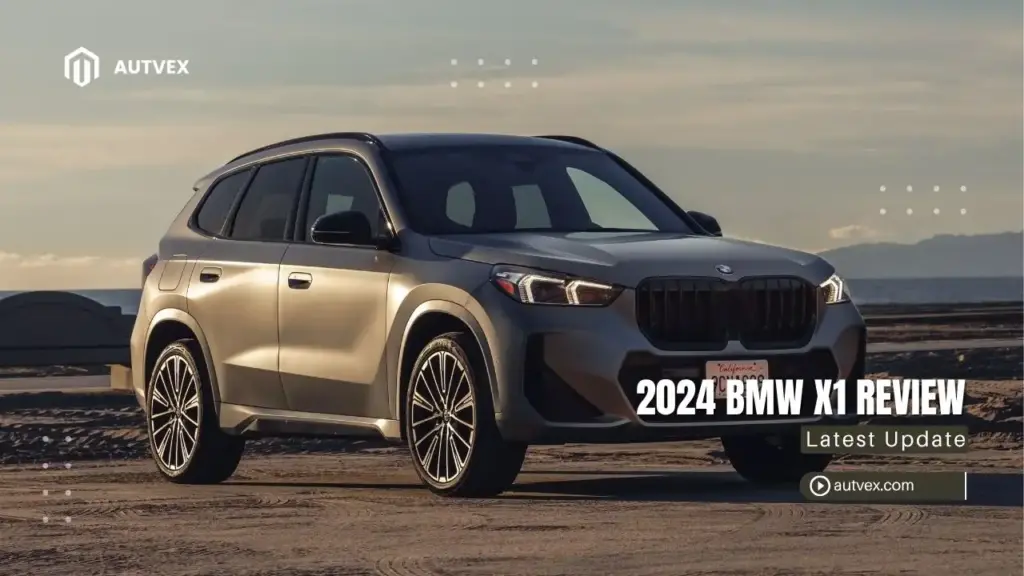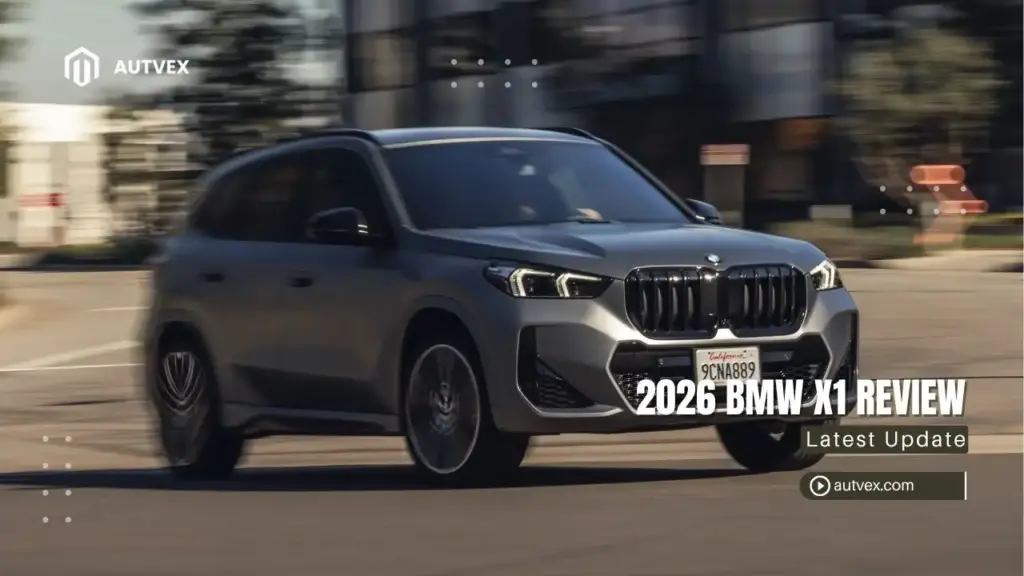You may also like:
The 2025 BMW X1 continues as BMW’s entry-level luxury compact SUV starting at $40,950 for xDrive28i and $50,530 for performance-focused M35i, representing a carryover design from the third-generation 2024 launch[1][2]. This model year adds meaningful standard features including heated front seats, wireless device charging, and Wi-Fi hotspot with eSIM 5G connectivity across all trims while maintaining the engaging driving dynamics that distinguish it from conservative rivals[1]. Powered by turbocharged 2.0-liter engines producing 241-312 horsepower, the X1 delivers 6.2-second (base) to 5.0-second (M35i) 0-60 mph acceleration while achieving EPA-estimated 24-33 MPG city/highway[2][3]. Car and Driver awards the X1 “Editors’ Choice” designation praising its combination of “athleticism, practicality, and upscale appointments”[2].
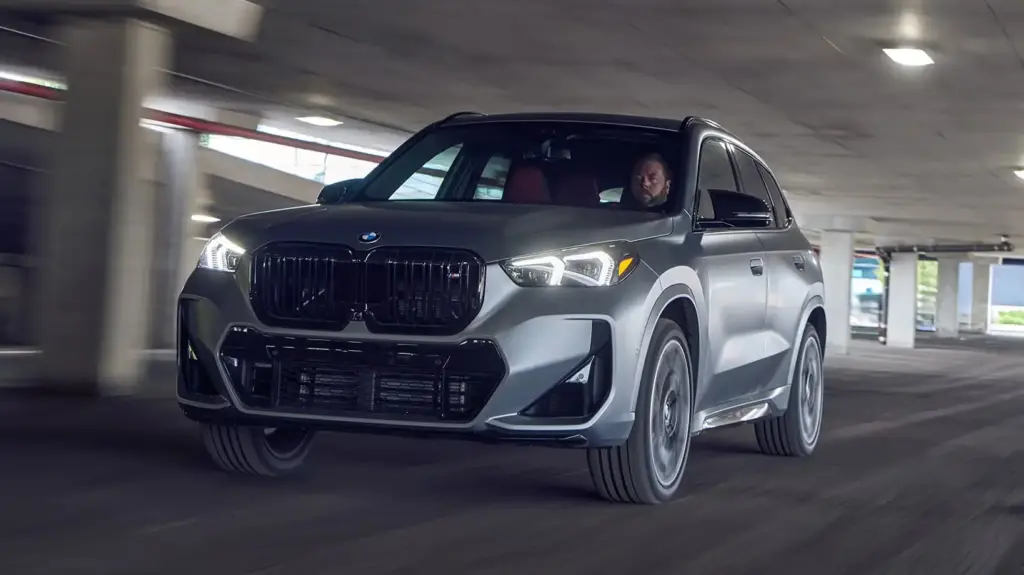
What’s New for the 2025 BMW X1
New Standard Features Added
BMW enhances the 2025 X1 value proposition by elevating previously optional comfort and convenience features to standard equipment across both trim levels. Heated front seats now come standard rather than requiring optional packages—a welcome change for cold-weather states[1]. Wireless device charging joins the standard equipment list accommodating modern smartphones without cable clutter.
Wi-Fi hotspot capability with eSIM 5G connectivity enables passengers to connect devices during journeys[1]. The X1 carries forward its redesigned third-generation chassis introduced for 2024, meaning no significant exterior or mechanical changes for 2025. This carryover approach allows BMW to refine the proven platform while adding value through enhanced standard equipment.
2025 Standard Equipment Additions:
- Heated front seats: Standard all trims (previously optional)
- Wireless charging: Eliminates cable requirements
- Wi-Fi hotspot: eSIM 5G connectivity standard
- Carryover redesign: Third-generation from 2024
- No exterior changes: Proven design continues
- No mechanical updates: Refinement focus
iDrive 9 Infotainment Update
The 2025 X1 receives BMW’s latest iDrive 9 operating system replacing previous generation’s iDrive 8[1]. This update delivers enhanced visual clarity and system responsiveness addressing previous criticisms regarding laggy interfaces. Wireless Apple CarPlay and Android Auto integration comes standard enabling seamless smartphone connectivity without physical cables.
However, the move to touchscreen-focused controls creates controversy among traditional BMW enthusiasts. The loss of physical buttons and beloved iDrive rotary controller forces climate control and other functions through touchscreen menus. Some reviewers note this creates frustration for drivers preferring tactile feedback[2]. The resulting minimalist cabin appearance trades traditional ergonomics for sleek aesthetics prioritizing visual design over functional simplicity. Understanding how long it takes to buy a car helps set realistic expectations for purchasing timelines when ordering your X1.
Pricing Updates & Market Positioning
Base xDrive28i pricing starts $40,950 MSRP plus approximately $1,175 destination totaling around $42,125 out-the-door[1][2]. Performance M35i commands $50,530-$51,975 MSRP depending on specification plus destination charges. Minor price adjustments reflect the added standard equipment value proposition.
Competitive positioning versus Audi Q3 and Volvo XC40 remains strong with the X1 offering superior driving dynamics and better standard equipment. According to Autvex automotive analysis, the X1 represents best value proposition in compact luxury SUV segment combining performance, features, and efficiency at accessible pricing. The $10,000+ gap between xDrive28i and M35i creates clear value segmentation appealing to budget-conscious buyers and performance enthusiasts respectively.
| Model | Starting MSRP | Destination | Total | Horsepower | MPG Combined |
|---|---|---|---|---|---|
| xDrive28i | $40,950 | ~$1,175 | ~$42,125 | 241 HP | 28 MPG |
| M35i | $50,530-51,975 | ~$1,175 | ~$51,705-53,150 | 312 HP | 26 MPG |
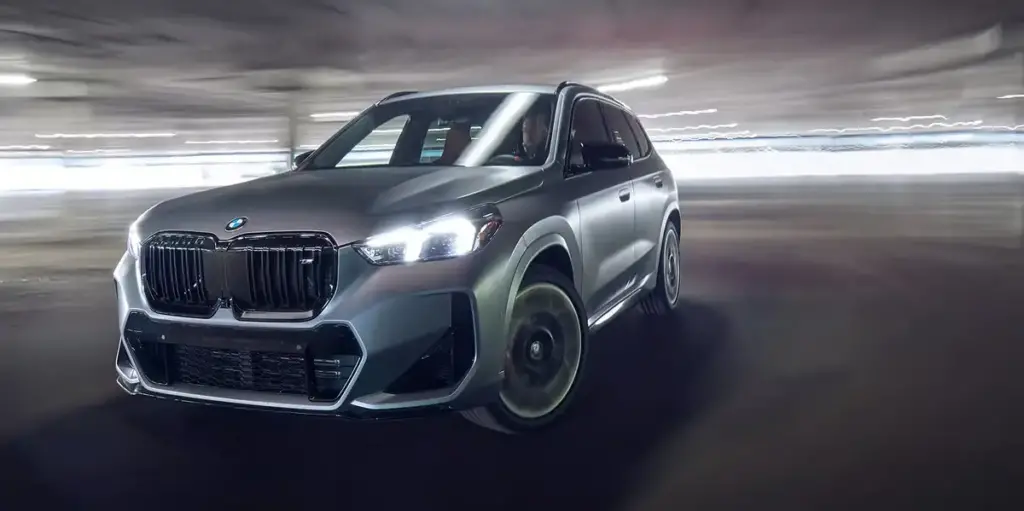
2025 BMW X1 Design & Styling
Third-Generation Exterior Design
The third-generation X1 redesigned for 2023 continues unchanged for 2025 showcasing bold evolution of BMW’s design language. A broad kidney-shaped grille with sharp edges dominates the front fascia creating unmistakable BMW identity. Large L-shaped air vents frame the grille emphasizing aggressive styling[1].
Tall profile with sleek aerodynamic contours balances SUV practicality with dynamic aesthetics. Dimensions measure 177.2 inches length, 72.6 inches width, and 64.6 inches height with 106.0-inch wheelbase maximizing interior volume[2][3]. Compact proportions facilitate urban maneuverability while premium execution positions X1 above typical subcompact crossovers.
Exterior Design Highlights:
- Kidney grille: Broad with sharp edges
- L-shaped vents: Large, aggressive styling
- LED headlights: Complement grille shape
- Tall profile: SUV stance with aerodynamics
- 177.2″ length: Compact yet spacious
- 106.0″ wheelbase: Interior space optimization
- Sculpted lines: Athletic body character
Build Quality & Dimensions
Substantial feel despite compact classification separates X1 from lesser competitors. Premium appearance exceeds expectations for entry-level positioning with quality materials and precise assembly. Standard 18-inch wheels on xDrive28i provide efficient rolling stock while M35i’s 19-inch wheels enhance visual presence[1].
Adaptive LED headlights standard on M35i automatically adjust beam patterns for optimal nighttime visibility. Optional black trim creates distinctive appearance emphasizing sporty character. Five-door configuration with five-passenger seating accommodates typical family needs while maintaining manageable dimensions for parking and city driving.
Design Strengths & Weaknesses
Bold, unapologetic styling differentiates X1 from conservative rivals like Mercedes-Benz GLB and even Audi Q3. The oversized kidney grille proves divisive among buyers—some appreciate bold statement while traditionalists prefer more restrained proportions. Muscular athletic stance with sharp creases creates dynamic profile emphasizing BMW’s sporty heritage[1].
Sculpted hood and angular body lines enhance visual interest versus bland competitors. Slim LED taillights with sporty diffuser create modern rear appearance. Overall design proves more visually striking than GLB and Q3 though personal taste ultimately determines preference. The X1’s design language aligns with buyers seeking statement piece rather than anonymous appliance. For those interested in BMW’s performance offerings, the BMW M5 Touring represents the brand’s ultimate sport wagon.
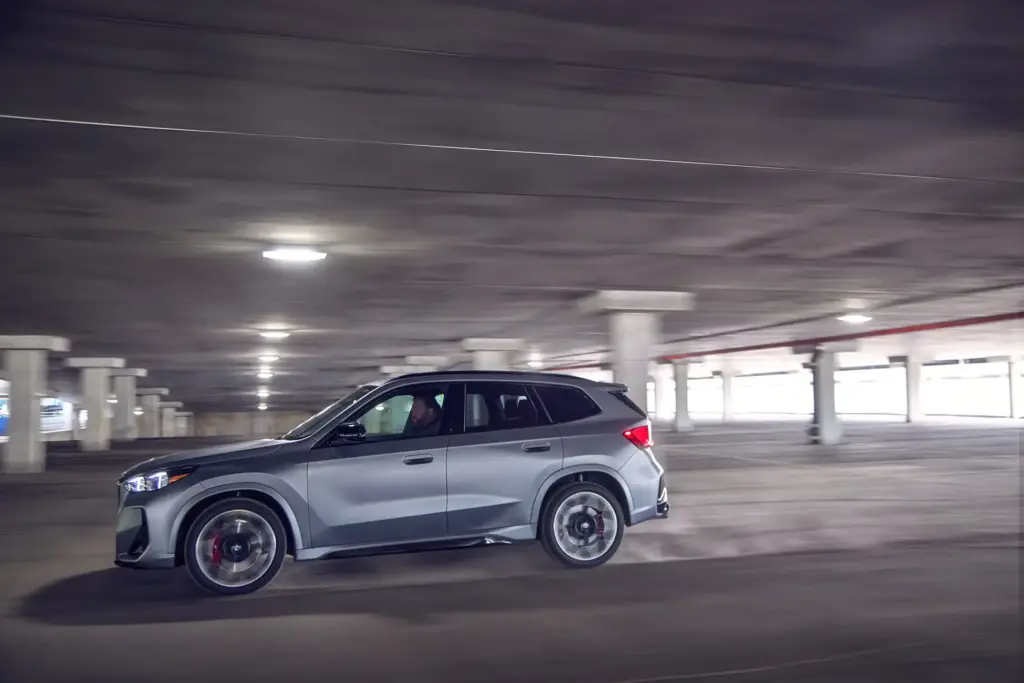
2025 BMW X1 Trim Levels & Pricing
xDrive28i: Base Model Overview
The base xDrive28i starts $40,950 MSRP plus destination delivering comprehensive equipment justifying premium positioning. Under hood sits BMW TwinPower Turbo 2.0L inline-four producing 241 horsepower at 4,500 rpm and 295 lb-ft torque from just 1,500 rpm[2][3]. This low-end torque enables confident acceleration from standstill.
BMW conservatively estimates 6.2-second 0-60 mph though real-world performance proves quicker for enthusiastic drivers[1][2]. Seven-speed dual-clutch automatic transmission provides lightning-fast shifts enhancing sport character. All-wheel drive (xDrive) standard across lineup ensures confident traction year-round conditions.
xDrive28i Standard Equipment:
- 241 HP turbocharged 2.0L engine
- 295 lb-ft torque from 1,500 rpm
- 6.2-second 0-60 mph (BMW estimate)
- 7-speed dual-clutch automatic
- xDrive AWD standard
- Heated front seats new standard 2025
- Wireless charging new standard 2025
- Wi-Fi hotspot with eSIM 5G
- BMW Curved Display with iDrive 9
- LED headlights standard
- Front/rear parking sensors
M35i: Performance Model Details
Performance M35i commands $50,530-$51,975 MSRP plus destination delivering 312-313 horsepower from enhanced BMW M TwinPower Turbo 2.0L engine[1][2]. Upgraded tuning with performance-optimized components delivers 295 lb-ft torque with more aggressive power delivery characteristics. BMW estimates 5.0-5.2 second 0-60 mph—sportscar-like acceleration for compact SUV[2].
Adaptive M suspension standard on M35i sharpens handling dynamics responding intuitively to driving conditions. M Sport Differential improves cornering dynamics distributing torque optimally between rear wheels. M Sport Brakes with upgraded calipers ensure superior stopping power matching enhanced performance[1].
| Feature | xDrive28i | M35i |
|---|---|---|
| Engine | 2.0L TwinPower Turbo | 2.0L M TwinPower Turbo |
| Horsepower | 241 HP | 312-313 HP |
| Torque | 295 lb-ft | 295 lb-ft (enhanced) |
| 0-60 mph | 6.2 seconds | 5.0-5.2 seconds |
| Suspension | Standard (adaptive optional) | Adaptive M standard |
| Differential | Standard | M Sport Differential |
| Brakes | Standard | M Sport upgraded |
| Wheels | 18-inch | 19-inch |
Standard Equipment Comparison
Both 2025 trims include comprehensive standard equipment separating BMW from budget competitors. The xDrive28i features heated seats, wireless charging, Wi-Fi hotspot, iDrive 9, and LED headlights as baseline[1]. M35i adds Harman Kardon audio, head-up display, 360-degree camera, interior camera, front cross-traffic alert, and augmented reality navigation[1].
Both include BMW Curved Display integrating 10.25-inch digital cluster with 10.7-inch touchscreen. Wireless Apple CarPlay and Android Auto enable seamless smartphone connectivity. Active Driving Assistant provides comprehensive safety suite including frontal collision warning, blind spot detection, and lane departure warning as standard[2].
Optional Packages Worth Considering
Strategic package selection enhances X1 capability without excessive spending. Convenience packages available for xDrive28i bundle desirable features at attractive pricing. Technology upgrades include navigation enhancements and premium audio system improvements. Driver assistance packages add lane centering and adaptive cruise control with stop-and-go capability[1].
Parking assistance systems simplify challenging parking situations. Buyers should carefully evaluate actual needs versus marketing appeal—many optional features prove rarely used in daily driving. Focus spending on features delivering genuine practical value rather than aspirational additions collecting dust.
Which Trim Level to Choose
Car and Driver recommends xDrive28i for most buyers noting M35i feels “too high-strung for everyday driving”[2]. Base model’s 241 HP proves sufficient for daily performance needs with confident acceleration and highway passing power. Better ride quality versus M35i’s firm tuning enhances daily driving comfort for non-enthusiast buyers.
The $10,000+ price difference proves difficult justifying for marginal performance advantage—most drivers won’t exploit M35i’s capabilities in typical commuting. M35i justified only for dedicated performance enthusiasts prioritizing ultimate handling sharpness and acceleration bragging rights. Base model delivers engaging driving experience satisfying vast majority while preserving funds for options, maintenance reserves, or future purchases. For those exploring other BMW models, the BMW 2-Series Gran Coupe offers sporty sedan alternative at similar pricing.
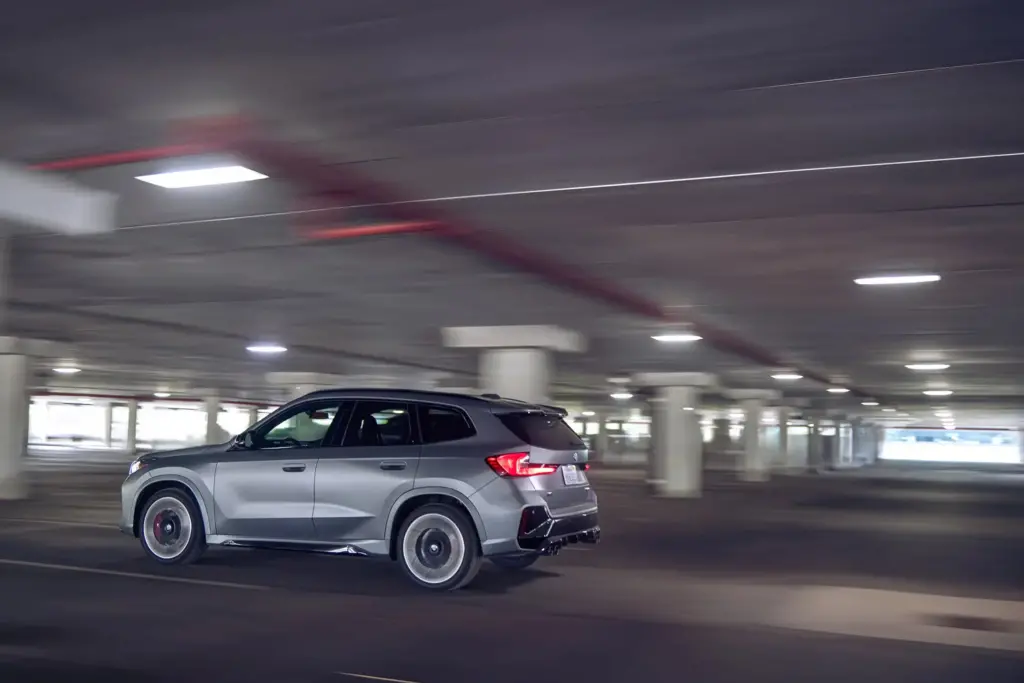
2025 BMW X1 Performance & Driving Dynamics
Engine Options & Specifications
Both 2025 trims utilize turbocharged 2.0-liter inline-four engine architecture with Miller-cycle technology. Aluminum block and head construction reduces weight improving power-to-weight ratio. Port and direct fuel injection optimizes efficiency and power delivery across rev range[2][3].
Standard xDrive intelligent all-wheel-drive system distributes torque optimally between front and rear axles. Seven-speed dual-clutch automatic transmission delivers quicker shifts than conventional automatic maintaining driver engagement. Twin-scroll turbocharging with variable valve control maximizes responsiveness minimizing lag[1].
Engine Technical Specifications:
- Configuration: Turbocharged inline-four
- Displacement: 2.0 liters (122 cubic inches)
- Construction: Aluminum block and head
- Technology: Miller-cycle with port/direct injection
- xDrive28i: 241 HP / 295 lb-ft
- M35i: 312-313 HP / 295 lb-ft
- Transmission: 7-speed dual-clutch
- Drivetrain: xDrive AWD standard
- Fuel: Premium unleaded recommended
Acceleration & Real-World Testing
BMW conservatively estimates 6.2-second 0-60 mph for xDrive28i though enthusiastic drivers typically achieve quicker times[2]. Quick, responsive performance suits compact SUV delivering confident acceleration from standstill and highway passing power. Some reviewers note noticeable turbo lag during aggressive throttle application though minimal during normal driving[2].
Performance M35i achieves 5.0-5.2 second 0-60 mph delivering sportscar-like acceleration rivaling dedicated performance vehicles[1][2]. Enhanced tuning with performance-optimized components creates more aggressive throttle response and sportier exhaust note. However, some owners report occasional engine surging affecting smooth power delivery in certain driving situations.
Handling & Driving Experience
The X1 earns universal praise as “one of most engaging vehicles to drive in its class” per automotive reviewers[2]. Quick, responsive steering praised universally provides excellent feedback and precision control. Composed handling with excellent grip inspires confident cornering approaching speeds exceeding typical compact SUV expectations.
Athletic character distinguishes X1 from bland rivals prioritizing comfort over engagement. My Modes functionality enables adjustment between Efficient, Sport, and Personal settings tailoring driving experience to preferences[1]. Speed-sensitive steering and anti-roll stabilizer bars reinforce planted feel through corners. Dynamic Stability Control enhances confidence maintaining composure during spirited driving.
Ride Quality & Comfort Balance
Base xDrive28i offers comfortable ride quality for daily driving situations. Balanced suspension absorbs bumps well while maintaining athleticism through corners—impressive compromise for enthusiast-oriented compact SUV. M35i’s Adaptive M Suspension proves noticeably firmer trading comfort for handling sharpness[4].
Sportier M35i tuning may prove too stiff for daily driving per multiple reviewers noting excessive firmness compromising everyday comfort[2][4]. Base model provides better all-around ride/handling compromise satisfying most buyers seeking balance between comfort and engagement. Adaptive dampers available as xDrive28i option help balance competing demands though standard suspension proves adequate for typical buyers.
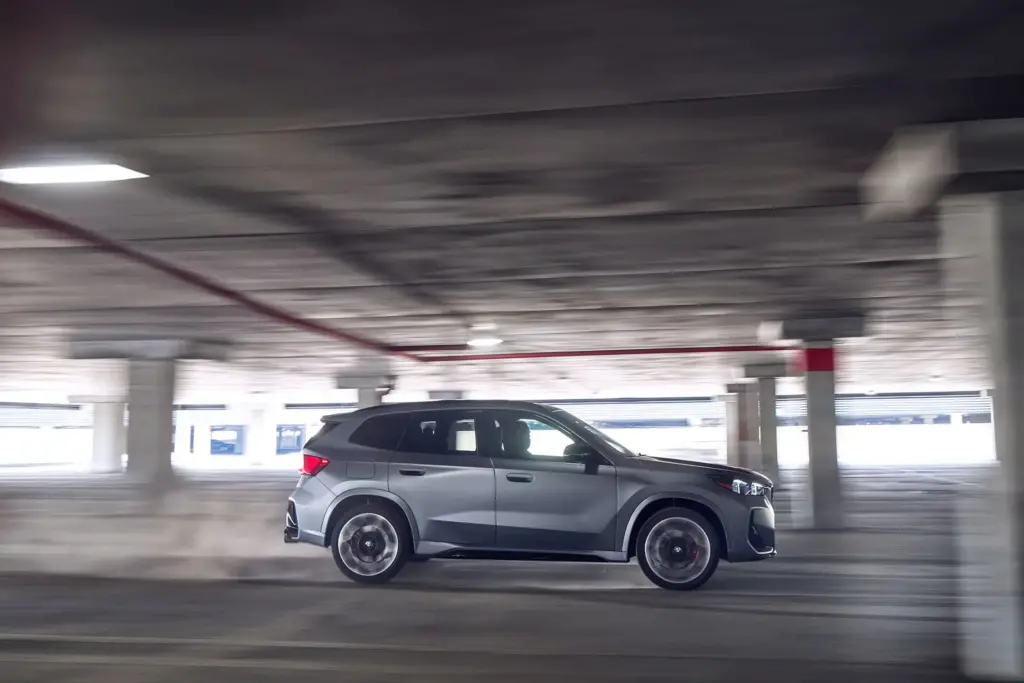
2025 BMW X1 Fuel Economy & Efficiency
EPA Ratings by Trim
The xDrive28i achieves EPA-estimated 24 city / 33 highway / 28 combined MPG delivering competitive efficiency for turbocharged all-wheel-drive luxury SUV[2][3]. Performance M35i returns slightly lower 23 city / 31 highway / 26 combined MPG reflecting sportier tuning and enhanced power output[1].
Better efficiency than Audi Q3 rated 21/28/24 MPG combined demonstrates BMW’s engineering advantage[4]. Competitive with Volvo XC40 in fuel economy across driving conditions. Premium unleaded fuel recommended both trims optimizing performance and efficiency though regular unleaded acceptable with reduced power output.
EPA Fuel Economy Comparison:
- X1 xDrive28i: 24 city / 33 highway / 28 combined
- X1 M35i: 23 city / 31 highway / 26 combined
- Audi Q3: 21 city / 28 highway / 24 combined
- Volvo XC40: Similar to X1 xDrive28i
- Mercedes GLB: Lower than X1
Real-World Fuel Economy Testing
Real-world testing reveals xDrive28i achieving up to 34 MPG highway under favorable conditions exceeding EPA highway estimate[1]. Consistent cruising speeds on flat terrain optimize efficiency demonstrating gap between laboratory testing and actual performance. 14.3-gallon fuel tank capacity provides approximately 400-mile range for xDrive28i and 370-mile range for M35i between refueling stops[1].
Mild hybrid system standard across lineup improves efficiency versus competitors lacking electrification. This technology captures energy during deceleration storing in small battery for reuse during acceleration reducing fuel consumption.
Cost to Operate & Efficiency Benefits
Better fuel economy than most luxury compact SUVs reduces long-term operating costs. Premium fuel requirement increases operating expenses approximately $0.30-0.50 per gallon versus regular unleaded—meaningful expense over ownership period. Overall efficiency remains competitive for turbocharged AWD SUV segment.
Lower fuel costs than larger BMW X3 justify X1 selection for buyers prioritizing efficiency. Efficiency advantage over Mercedes-Benz GLB further strengthens value proposition. According to Autvex cost analysis, X1 fuel expenses remain manageable for buyers accepting premium fuel as luxury vehicle ownership cost.
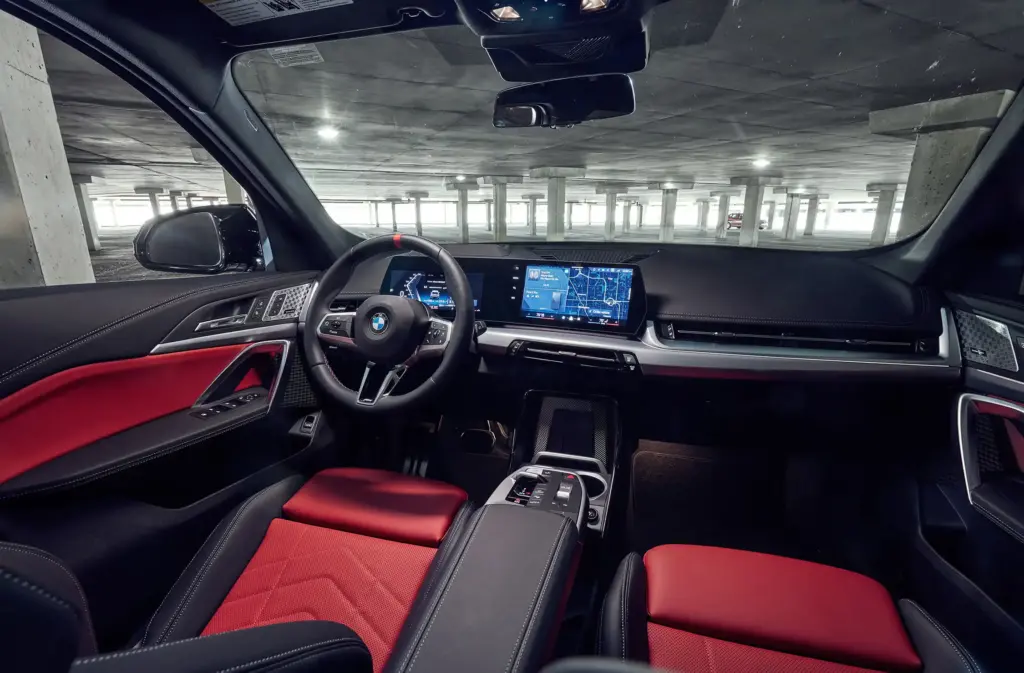
2025 BMW X1 Interior & Comfort
Cabin Design & Layout
Tech-forward minimalist design philosophy defines modern BMW interiors prioritizing digital integration. Major improvement over previous generation’s criticized interior addressing historical weakness. Clean, techy aesthetic with modern execution appeals to technology-focused buyers[1].
Floating center console creates open feel maximizing perceived spaciousness. Minimalist shift lever design occupies minimal space. Reduced physical buttons emphasizing touchscreen creates sleek appearance though functionality suffers per traditionalist reviewers. High-quality materials throughout cabin justify premium positioning with soft-touch surfaces and attractive trim options[2].
Interior Design Elements:
- Minimalist philosophy: Digital-first approach
- Floating console: Open, spacious feel
- Minimalist shifter: Space-efficient design
- Reduced buttons: Touchscreen emphasis
- High-quality materials: Soft-touch surfaces
- Attractive trim: Multiple finish options
- Modern execution: Contemporary aesthetic
BMW Curved Display & iDrive 9
Single-piece curved glass houses dual displays creating seamless visual integration. 10.25-inch digital instrument cluster provides customizable driver information while 10.7-inch central touchscreen serves as command center[1]. iDrive 9 operating system delivers enhanced responsiveness addressing previous generation lag complaints.
Visual clarity praised by reviewers improves readability under various lighting conditions. Wireless Apple CarPlay and Android Auto standard enable seamless smartphone integration without cable clutter. However, some reviewers miss physical controls from previous generation preferring tactile feedback over touchscreen dependency[2]. Natural language voice controls understand conversational commands though accuracy varies by accent and background noise.
Materials & Build Quality
High-quality materials with soft-touch surfaces throughout elevate perceived luxury. Attractive trim options including wood finishes provide personalization opportunities. Standard synthetic leather (SensaTec) upholstery delivers premium tactile quality rivaling genuine leather[1].
Optional premium leather available for buyers preferring traditional materials. Eucalyptus open-pore wood trim optional adds natural elegance complementing modern aesthetic[2]. Sturdy construction with quality materials creates solid, substantial feel. Zero creaks or rattles reported by positive reviewers praising assembly quality—significant improvement over previous generations suffering durability complaints[5].
Space & Passenger Accommodations
Surprisingly spacious for compact SUV classification exceeding typical segment expectations. Roomy interior compared to rivals per reviews accommodates adults comfortably front and rear. Ample space for passengers delivers generous legroom both rows preventing cramped feeling during extended journeys[2].
Sufficient headroom for taller passengers approaching six feet without uncomfortable head positioning. Five-passenger seating capacity suits typical family needs accommodating parents plus three children comfortably. More space than typical subcompact crossover competing above weight class in interior dimensions. Long 106.0-inch wheelbase creates impressive interior volume maximizing space efficiency[2].
Cargo Space & Storage
Cargo capacity measures 57.2 cubic feet for xDrive28i with rear seats folded providing class-competitive utility[1][2]. Behind upright rear seats, 25.7 cubic feet accommodates everyday hauling needs including groceries and sports equipment. More cargo than many competitors in segment including Audi Q3.
Edges out Audi Q3 for cargo capacity though falls short of Mercedes-Benz GLB’s class-leading space accommodating larger families. 40/20/40 split-folding rear seats enable flexible cargo configurations balancing passenger and cargo needs. Low load floor facilitates easy loading eliminating excessive lifting. For buyers considering alternatives, understanding what happens when your car is totaled but still drivable provides valuable insurance knowledge.
| Cargo Capacity | BMW X1 xDrive28i | Audi Q3 | Mercedes GLB | Volvo XC40 |
|---|---|---|---|---|
| Seats Folded | 57.2 cu ft | ~54 cu ft | 62 cu ft | 57.5 cu ft |
| Seats Up | 25.7 cu ft | ~24 cu ft | ~24 cu ft | ~25 cu ft** |
| Split Folding | 40/20/40 | 40/20/40 | 40/20/40 | 60/40 |
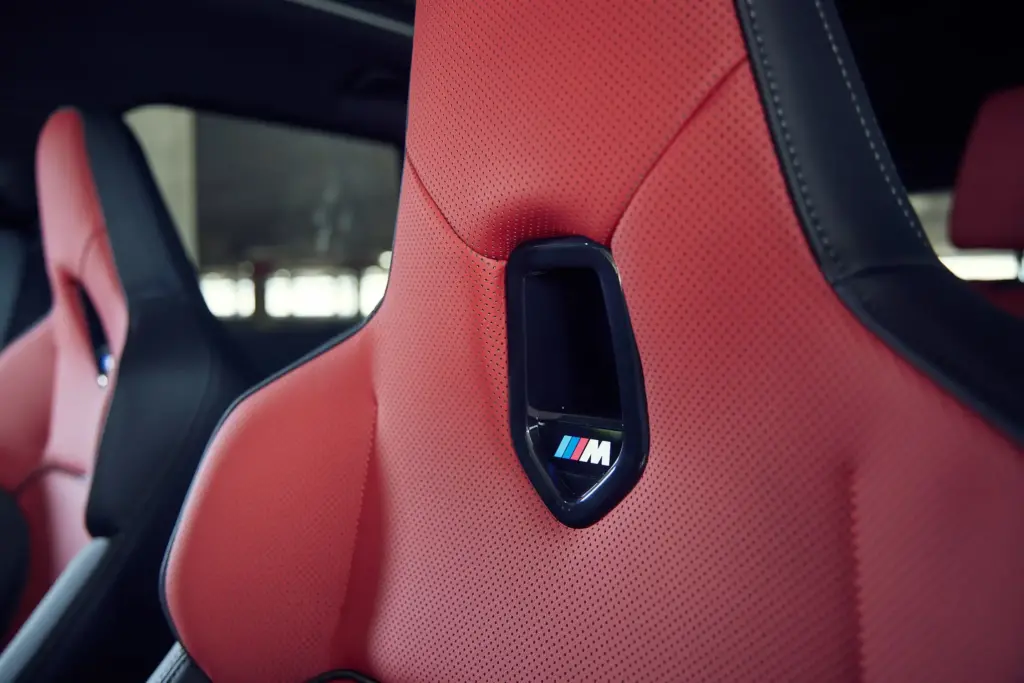
2025 BMW X1 Technology & Features
iDrive 9 Infotainment System
Latest generation iDrive 9 operating system represents significant advancement over previous iterations addressing responsiveness complaints. Remote software upgrades capability ensures system currency throughout ownership—BMW promises improvements via over-the-air updates[1]. Enhanced visual clarity and system responsiveness improve user experience.
Touch interface praised for smoothness responding quickly to inputs. Wireless smartphone integration standard eliminates cable requirements. My BMW App enables remote vehicle control including climate preconditioning, door lock status checking, and vehicle location tracking. Navigation system standard provides turn-by-turn directions with real-time traffic information. Voice controls with natural language processing understand conversational commands though accuracy varies[2].
Touch-Heavy Controls & Interface
Touchscreen-only interface for most functions creates controversy among traditional BMW enthusiasts. Loss of physical buttons and beloved iDrive rotary controller forces climate control adjustments through touchscreen menus. Frustrating for drivers preferring tactile feedback enabling eyes-on-road operation[2].
Learning curve exists for touchscreen dependency requiring familiarization period. More distracting than physical controls per multiple reviewers noting safety concerns from eyes-off-road interaction. However, sleek appearance results from minimalist approach appealing to design-conscious buyers prioritizing aesthetics. Button elimination creates clean dashboard emphasizing curved display visual impact.
Standard Technology Features
Comprehensive standard technology justifies premium positioning distinguishing BMW from budget competitors. BMW Curved Display with dual screens integrates seamlessly. 10.25-inch digital instrument cluster provides customizable driver information. 10.7-inch central touchscreen serves as infotainment command center[1].
Wireless Apple CarPlay and Android Auto enable smartphone integration. Wireless device charging new for 2025 accommodates modern smartphones. Wi-Fi hotspot with eSIM 5G connectivity added 2025 enables passenger device connections. My BMW App connectivity provides remote vehicle access. Multiple USB ports throughout cabin charge passenger devices during journeys[1].
Optional Technology Upgrades
Head-up display standard on M35i and optional for xDrive28i projects key information onto windshield. 360-degree surround-view camera standard M35i and optional xDrive28i simplifies parking in tight spaces. Augmented reality navigation overlay on M35i enhances situational awareness overlaying directions on real-world camera view[1].
Interior camera for driver monitoring on M35i enables advanced safety features. Harman Kardon premium audio standard M35i delivers concert-quality acoustics. Front cross-traffic alert on M35i warns of approaching traffic when backing from parking spaces. Enhanced driver assistance features provide semi-autonomous capabilities approaching hands-free operation in specific conditions.
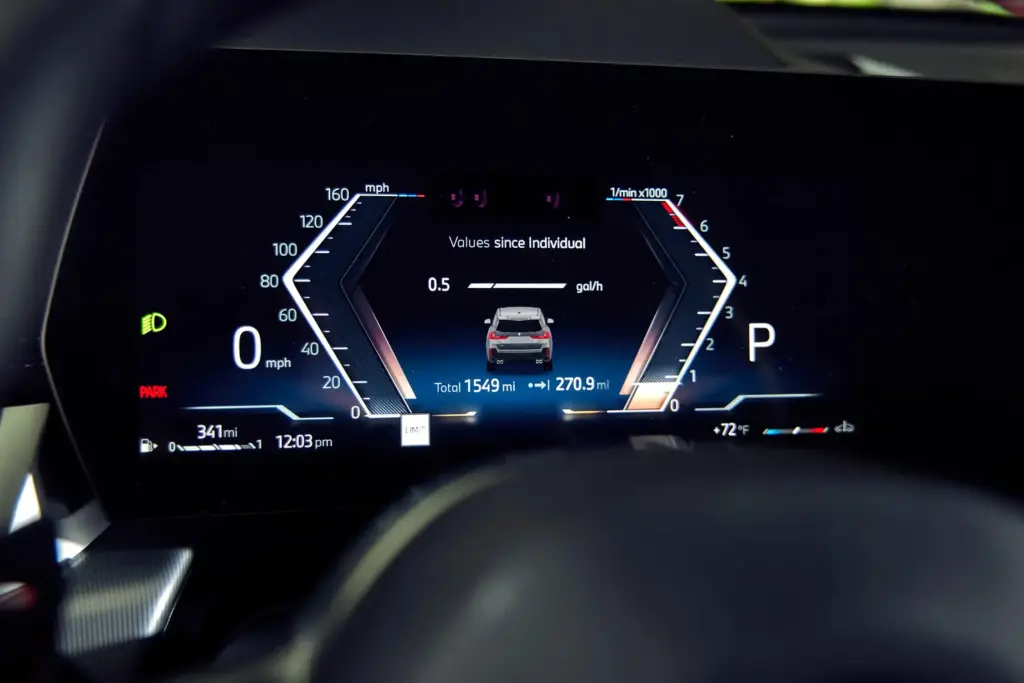
2025 BMW X1 Safety Features
Standard Active Safety Systems
Comprehensive active safety technologies standard across lineup distinguish BMW from budget competitors. Active Driving Assistant standard all trims provides multi-faceted protection. Frontal Collision Warning with automatic emergency braking detects potential impacts applying brakes automatically if driver fails responding[1][2].
Active Blind Spot Detection standard monitors adjacent lanes alerting drivers to vehicles in blind spots. Lane Departure Warning standard alerts when drifting from lane without signaling. Speed Limit Information display shows current posted limits. Pedestrian detection capability identifies pedestrians in vehicle path. Dynamic cruise control standard maintains set speed and following distance. Front and rear parking sensors standard provide comprehensive coverage facilitating confident maneuvering[1].
Standard Safety Equipment:
- Active Driving Assistant comprehensive suite
- Frontal Collision Warning with auto braking
- Blind Spot Detection standard
- Lane Departure Warning standard
- Speed Limit Information display
- Pedestrian detection capability
- Dynamic cruise control standard
- Parking sensors front/rear standard
- Seven airbags comprehensive coverage
Optional Driver Assistance Packages
Adaptive cruise control with stop-and-go capability available as optional upgrade maintaining set following distance automatically bringing vehicle to complete stops in congestion. Lane centering assistance optional for xDrive28i and standard M35i maintains lane position with gentle steering inputs[1].
Traffic Jam Assist optional provides semi-autonomous operation in congested traffic. Active driving assistance packages available expand capabilities approaching hands-free operation in specific conditions. Low-speed hands-free driving available on M35i enables automated operation under 40 mph in certain conditions. 360-degree camera system standard M35i and optional xDrive28i provides comprehensive view during parking. Front cross-traffic alert on M35i monitors for approaching traffic at intersections[1].
Crash Test Ratings & Results
NHTSA crash test ratings pending publication for 2025 model year as testing cycle not yet completed. IIHS testing results not yet available awaiting laboratory evaluation. Euro NCAP ratings available for international markets providing baseline safety assessment[6].
Third-generation chassis designed with advanced safety engineering incorporating crumple zones, reinforced passenger cell, and strategic energy absorption. Seven airbags provide comprehensive occupant protection. Electronic stability control and traction control system standard enhance vehicle stability preventing loss of control[1]. Final NHTSA and IIHS ratings expected following official testing completion later in 2025 model year.
Known Safety Issues & Concerns
Some owners report electronic system malfunctions affecting safety feature operation. Infotainment system freezing reported by some owners potentially affecting rearview camera display. CarPlay connection cutting out at critical times represents safety concern during navigation-dependent driving[5].
Brake noises reported by some third-generation owners requiring dealer diagnosis and potential component replacement. Auto start-stop system can lurch forward creating potential safety hazard in close-quarters traffic situations. Service required for electronic issues under warranty though repairs can waste time and create inconvenience. BMW investigating recurring issues addressing through software updates and component replacements as needed[5].
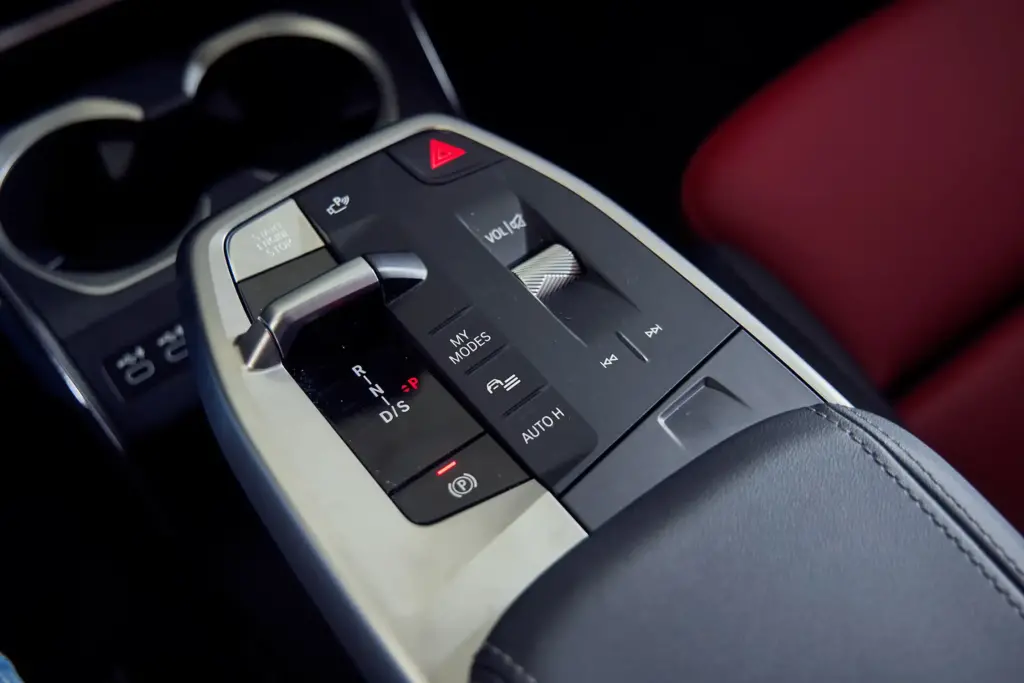
2025 BMW X1 Reliability & Common Problems
Third-Generation Reliability Overview
Third generation (2023+) remains relatively new with limited long-term reliability data available making definitive assessment premature. Mixed owner reviews regarding dependability create uncertainty—some owners report excellent reliability experiencing zero issues while others encounter multiple service visits within first year[5][7].
Build quality improvements over previous generations address historical BMW criticism regarding interior durability and electronic reliability. J.D. Power reliability rating for 2022 previous-generation X1 scored 83 out of 100 indicating above-average dependability though third-generation ratings not yet available[7]. Consumer Reports gave 2018 X1 overall reliability score 4.5 out of 5 considered “very good” though again not representative of current generation.
Common Problems & Owner Complaints
Auto start-stop system rough and hesitant represents most frequent complaint across owner forums. System can only be disabled through touchscreen menu rather than physical button—defaults to “ON” every ignition cycle frustrating owners who prefer disabling feature[5]. Significant lag when stopped requiring finesse managing throttle/brake preventing jerky operation.
Infotainment system unresponsive controls reported with screen freezing and occasional system crashes requiring restart. Electronic issues affect various systems including parking sensors and climate control. Turbocharger problems reported in some units including oil leaks and reduced power output requiring dealer service[7].
Common Owner Complaints:
- Auto start-stop: Rough, hesitant, lurches forward
- Infotainment freezing: System crashes, reboots
- Screen unresponsiveness: Touchscreen delays
- Electronic malfunctions: Various system issues
- Turbo problems: Oil leaks, power reduction
- Transmission hesitation: Rough shifting reported
- Sensor malfunctions: Parking assist, climate
Specific Issues Reported by Owners
Brake noises including banging when braking reported requiring dealer diagnosis. One Vermont owner reported vehicle wouldn’t start requiring jump-start creating significant inconvenience[5]. CarPlay connection cutting out at critical navigation times represents major frustration during unfamiliar area driving.
Steering and braking vibration reported during routine operation suggesting component wear or defects. Rough shifting or hesitation in transmission affecting smooth operation. Malfunctioning sensors including parking assist and AC system requiring calibration or replacement. Suspension component premature wear reported though limited data prevents determining pattern severity. Some owners report vehicle performing differently after break-in period suggesting adaptation period[5].
Warranty Coverage & Service
Basic warranty covers 4 years / 50,000 miles matching powertrain warranty duration providing comprehensive protection during critical ownership period[6]. Roadside assistance included during warranty period. Service network widely available across United States though dealership service quality varies significantly by location—some owners report excellent service while others experience frustration.
Repairs under warranty can still waste considerable time creating inconvenience. Some owners report losing hotel deposits due to unexpected breakdowns during travel[5]. Parts availability can affect repair timelines extending service visits. Extended warranty consideration provides peace of mind for buyers concerned about post-warranty repair costs.
Long-Term Ownership Considerations
Premium fuel requirement increases operating costs versus mass-market competitors accepting regular unleaded. Maintenance costs typical for BMW luxury brand though parts costs reflect premium positioning commanding higher prices than mainstream alternatives. Labor rates higher than mainstream brands reflecting dealership overhead and technician training requirements[7].
Electronic complexity may lead to future issues as vehicle ages and components approach end-of-life. Regular maintenance critical for reliability following BMW recommended service schedules. Extended warranty consideration provides financial protection against expensive repairs after factory warranty expires—particularly important given electronic system complexity. For buyers exploring certified pre-owned options, understanding how many miles is good for a used car helps set realistic expectations.
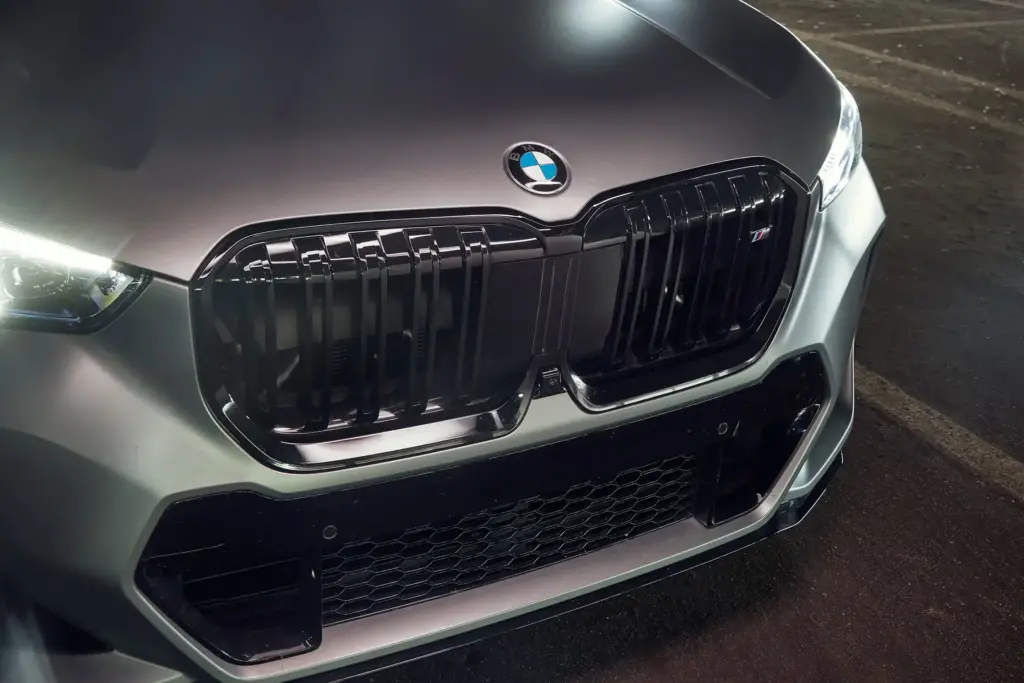
2025 BMW X1 vs Competitors
BMW X1 vs Audi Q3 (All-New for 2025)
Pricing comparison shows X1 $40,950 versus Q3 similar starting price positioning both competitively. Power advantage favors X1 with 241 HP versus Q3’s 228 HP in base trims delivering quicker acceleration[4][8]. X1 achieves quicker 0-60 mph times providing more engaging performance character.
Fuel economy significantly favors X1 with 28 MPG combined versus Q3’s 24 MPG combined—meaningful 4 MPG advantage reducing long-term operating costs[4]. Cargo capacity edge goes to X1 with 57.2 cubic feet versus Q3’s approximately 54 cubic feet providing more utility. Handling characteristics favor X1 with more engaging, athletic character versus Q3’s composed but less exciting dynamics[8].
Interior technology both modern though different implementation philosophies—Audi’s Virtual Cockpit versus BMW’s Curved Display represent competing visions. Value assessment slightly favors X1 with better standard equipment and superior efficiency though personal preference ultimately determines winner. The Q3 offers refined, comfortable driving experience while X1 prioritizes sportiness.
BMW X1 vs Mercedes-Benz GLB
Space advantage strongly favors GLB offering significantly more cargo with approximately 5+ cubic feet advantage over X1[2]. Seating capacity win decisively goes to GLB with available third row accommodating seven passengers—critical differentiator for larger families versus X1’s five-passenger limitation.
Handling dominance belongs to X1 delivering significantly more athletic and engaging dynamics versus comfort-focused GLB prioritizing smooth ride[2]. Fuel economy favors X1 with better efficiency ratings reducing operating costs. Pricing positions GLB slightly higher reflecting additional space and seating capacity premium.
Technology offerings comparable between both German luxury brands delivering comprehensive modern systems. Value determination depends on priorities—X1 for driving dynamics and efficiency, GLB for maximum space and seating flexibility. Buyers needing third-row seating have no X1 option making GLB necessary consideration despite higher pricing.
BMW X1 vs Volvo XC40
Pricing advantage favors Volvo XC40 starting lower around $39,900 versus X1’s $40,950—approximately $1,000 savings for budget-conscious buyers[4]. Cargo capacity nearly identical with XC40’s 57.5 cubic feet essentially matching X1’s 57.2 cubic feet eliminating utility advantage either direction.
Fuel economy ratings very similar between both delivering competitive efficiency. Handling engagement strongly favors X1 providing more enjoyable driving experience for enthusiasts prioritizing dynamics[4]. Safety ratings reputation advantage goes to Volvo with brand’s legendary safety leadership though specific 2025 crash test data pending.
Technology both offer comprehensive modern features representing different brand philosophies—Volvo’s Scandinavian minimalism versus BMW’s performance-focused approach. Interior design represents different philosophies both delivering premium execution with quality materials. Value assessment depends on priorities—XC40 better starting price and safety reputation, X1 superior driving dynamics and brand prestige.
BMW X1 vs Larger BMW X3
Pricing starts significantly higher for X3 reflecting larger dimensions and enhanced equipment. Size advantage X3 with larger dimensions providing more interior space and cargo capacity. Performance similar powertrain options available both models though X3 benefits from additional engine choices[2].
Handling both deliver BMW’s athletic character though X3 benefits from longer wheelbase improving high-speed stability. Fuel economy advantage X1 due to smaller size and lighter weight reducing consumption. Value proposition favors X1 as better entry price for BMW brand enabling ownership at lower cost threshold.
Space advantage X3 for buyers needing maximum room accommodating larger families or cargo requirements. Decision framework suggests X1 sufficient for most buyers while X3 necessary only when additional space justifies premium pricing. For buyers considering BMW’s broader lineup, exploring compare Audi Q5 vs BMW X3 provides valuable cross-brand insights.
| Comparison Point | BMW X1 | Audi Q3 | Mercedes GLB | Volvo XC40 |
|---|---|---|---|---|
| Starting Price | $40,950 | ~$42,000 | ~$45,000 | $39,900 |
| Horsepower | 241 HP | 228 HP | 221 HP | 228 HP |
| 0-60 mph | 6.2 sec | 7.1 sec | 7.2 sec | ~7.0 sec |
| MPG Combined | 28 MPG | 24 MPG | 25 MPG | ~28 MPG |
| Cargo (folded) | 57.2 cu ft | ~54 cu ft | 62 cu ft | 57.5 cu ft |
| Seating | 5 pass | 5 pass | 5-7 pass | 5 pass |
| Key Advantage | Dynamics | Tech | Space | Safety |
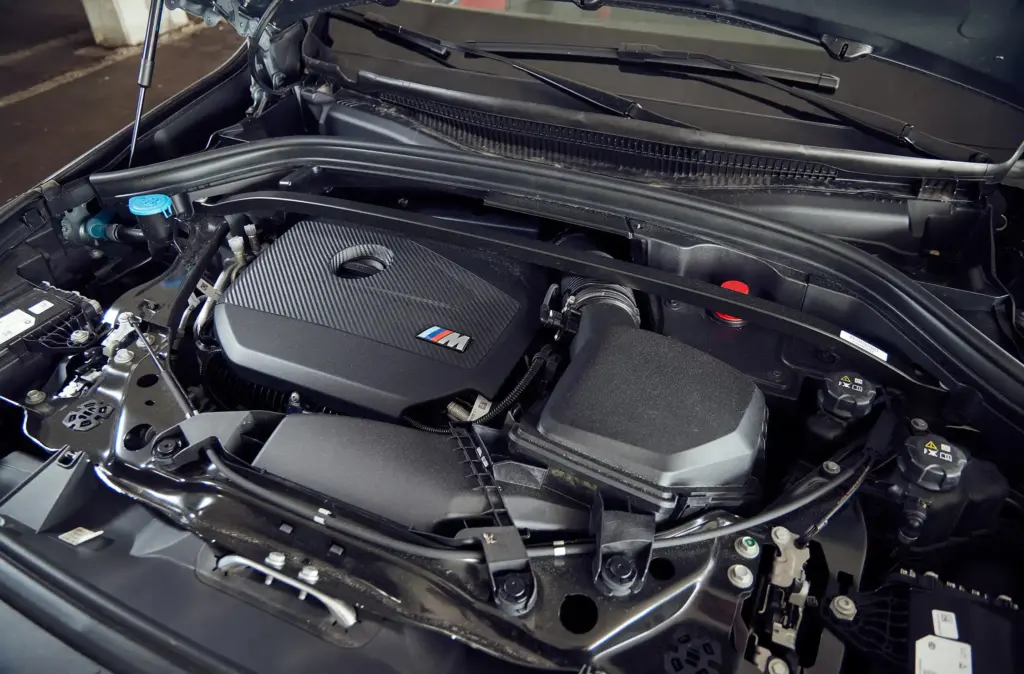
2025 BMW X1 Ownership Costs & Value
Purchase Price & Market Positioning
Starting MSRP $40,950 for xDrive28i plus approximately $1,175 destination totals around $42,125 out-the-door before taxes and fees[1][2]. Performance M35i commands $50,530-$51,975 plus destination for approximately $51,705-$53,150 total. Transaction prices may trend lower than MSRP depending on local market conditions and dealer inventory levels.
Positioned competitively in luxury compact SUV segment between mass-market offerings and ultra-premium alternatives. Better value than Mercedes-Benz GLB starting higher around $45,000. Matches or beats Audi Q3 pricing while delivering superior performance and efficiency. More expensive than budget-friendly Volvo XC40 though justifiable through enhanced driving dynamics and brand prestige.
Total Cost of Ownership Analysis
Insurance costs typical for luxury SUV segment ranging $1,200-1,800 annually depending on location, driver age, and coverage levels. Premium fuel requirement increases operating expenses approximately $300-500 annually versus regular unleaded depending on driving patterns. Maintenance costs competitive for luxury class though parts reflect BMW premium positioning[7].
Depreciation typical for BMW brand expecting 20-25% first year decline though strong demand supports values. Four-year/50,000-mile warranty coverage provides peace of mind during critical ownership period. Repair costs after warranty reflect luxury positioning commanding premium labor rates and parts pricing. Electronic complexity may increase long-term costs as vehicle ages and components approach end-of-life requiring replacement.
Value Comparison Within Segment
More standard features than most competitors justifying premium pricing through enhanced equipment levels. Better fuel economy than rivals reduces operating costs over ownership period—28 MPG combined beats segment average. Athletic handling justifies premium for enthusiasts prioritizing engagement over anonymous appliance[2].
Spacious interior compared to segment rivals maximizes utility within compact footprint. Advanced technology standard across lineup eliminates need for expensive option packages. Strong value proposition per U.S. News recommendation citing “solid acceleration, excellent fuel economy, and beautifully appointed interior”[1]. “Best all around pick in its class” per owner review emphasizes comprehensive capability balancing competing demands[5].
Resale Value & Depreciation
Typical luxury SUV depreciation patterns expected following 20-25% first year, 40-45% three years, and 55-60% five years decline curves. Strong BMW brand recognition supports residual values versus less established competitors lacking prestige. Third-generation newer technology should hold value better than previous generations benefiting from modern features[7].
Compact luxury SUV segment highly competitive affecting all brand values through market saturation. Reliability concerns may affect future resale if electronic issues prove widespread though limited data prevents definitive assessment. Market demand strong for compact luxury SUVs supporting reasonable resale pricing. Consider certified pre-owned for value buyers accepting slight depreciation in exchange for substantial savings versus new pricing.
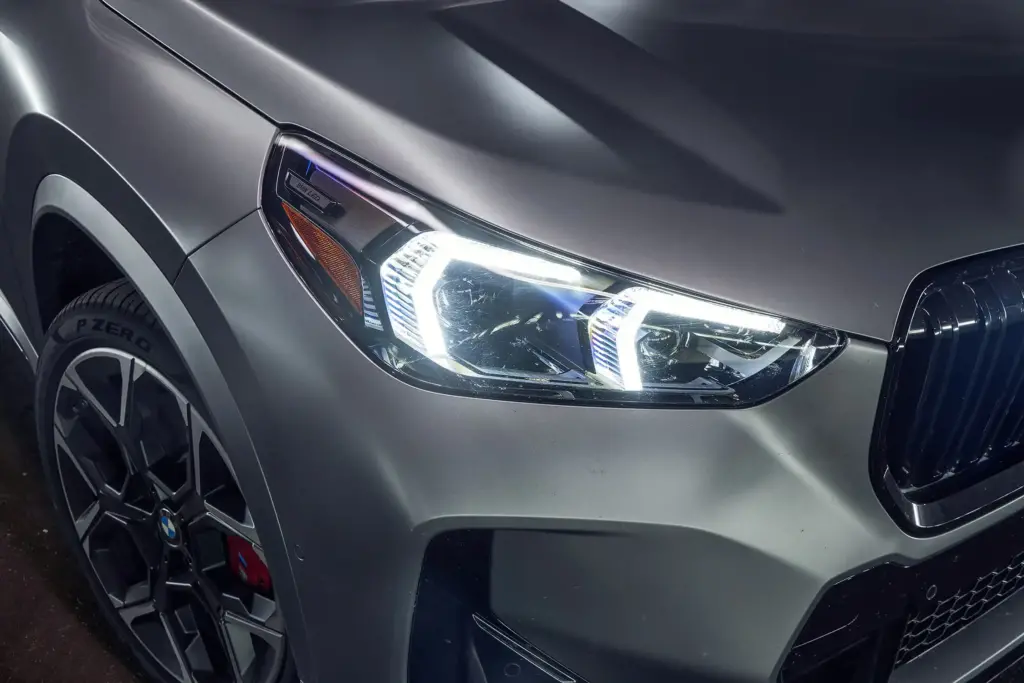
Should You Buy the 2025 BMW X1?
Who the 2025 X1 Is Perfect For
Drivers prioritizing engaging handling and dynamics find X1 delivers involvement lacking in bland competitors emphasizing comfort over excitement. Tech-savvy buyers accepting touchscreen controls embrace minimalist cabin design appreciating modern aesthetic. Those wanting BMW brand at accessible price discover gateway into premium marque at $40,950 entry point[1][2].
Buyers needing spacious compact luxury SUV appreciate generous interior volume approaching midsize dimensions. Enthusiasts seeking fun-to-drive daily vehicle enjoy athletic character distinguishing X1 from conservative alternatives. Families wanting premium SUV with room benefit from 57.2 cubic feet cargo capacity and comfortable five-passenger accommodations[1][2]. First-time BMW buyers entering brand discover accessible introduction to ownership at reasonable pricing.
Ideal Buyer Profile:
- Enthusiasts prioritizing athletic handling
- Tech buyers accepting touchscreen interface
- BMW brand aspirants seeking entry pricing
- Compact SUV buyers needing space
- Fun-to-drive daily driver seekers
- Five-passenger family accommodations
- First-time BMW ownership entry
Who Should Consider Alternatives
Buyers needing third-row seating must consider Mercedes-Benz GLB as X1 accommodates only five passengers eliminating large family option. Those on tighter budgets find Volvo XC40 starting approximately $1,000 less providing savings justifying compromised driving dynamics[4].
Buyers preferring physical controls over touchscreen interface should consider older generation X1 or competitors maintaining traditional layouts[2]. Those prioritizing maximum cargo space discover Mercedes-Benz GLB provides class-leading capacity exceeding X1 by 5+ cubic feet. Buyers wanting proven long-term reliability record may prefer waiting for more third-generation data before committing. Those avoiding premium fuel costs find mass-market competitors accepting regular unleaded more economical[7]. Drivers preferring softer, more compliant ride discover M35i too stiff while even xDrive28i leans sporty versus plush.
Base xDrive28i vs M35i: Which to Buy
Base xDrive28i recommended by most reviewers for majority of buyers delivering balanced capability. Car and Driver specifically notes M35i feels “too high-strung for everyday driving” compromising comfort for marginal performance gains[2]. Base model’s 241 HP proves sufficient for daily performance needs providing confident acceleration and highway passing power.
Better ride quality in xDrive28i versus firm M35i enhances daily driving comfort for non-enthusiast buyers prioritizing all-around capability. $10,000+ price difference proves hard justifying for marginal performance advantage most drivers won’t exploit in typical commuting[1]. M35i justified only for dedicated performance enthusiasts prioritizing ultimate handling sharpness and acceleration bragging rights. U.S. News specifically recommends xDrive28i citing “sufficient power and good value” as primary justifications[1].
Common Pitfalls to Avoid
Don’t overpay for M35i unless performance represents genuine priority rather than aspirational thinking—most buyers rarely exploit capabilities. Verify all recalls completed on used models checking NHTSA database for outstanding campaigns. Test touchscreen controls extensively before buying ensuring comfort with interface eliminating post-purchase frustration[6].
Check auto start-stop system operation during test drive assessing tolerance for behavior—system cannot be permanently disabled creating ongoing annoyance. Verify electronic systems function properly testing infotainment, safety features, and climate controls eliminating delivery-day surprises. Consider extended warranty for electronic protection given complexity potentially causing expensive post-warranty repairs[5][7]. Avoid early production units if reliability concerns exist allowing BMW time addressing initial quality issues through running changes.
Final Verdict & Expert Consensus
Car and Driver awards “Editors’ Choice” designation for 2025 praising combination of “athleticism, practicality, and upscale appointments” setting segment benchmark[2]. U.S. News recommends specifically for “solid acceleration, excellent fuel economy, and beautifully appointed interior” citing comprehensive capability[1].
One of most engaging vehicles in segment to drive per universal reviewer consensus emphasizing handling excellence. Touchscreen dependency represents main drawback for traditionalists preferring physical controls though modern buyers accept tradeoff. “Best all around pick in its class” per owner review emphasizes balanced execution[5]. Strong value proposition in competitive segment balancing performance, features, efficiency at accessible pricing. Recommended for buyers prioritizing driving dynamics over anonymous comfort though conservative alternatives serve buyers preferring softer character.
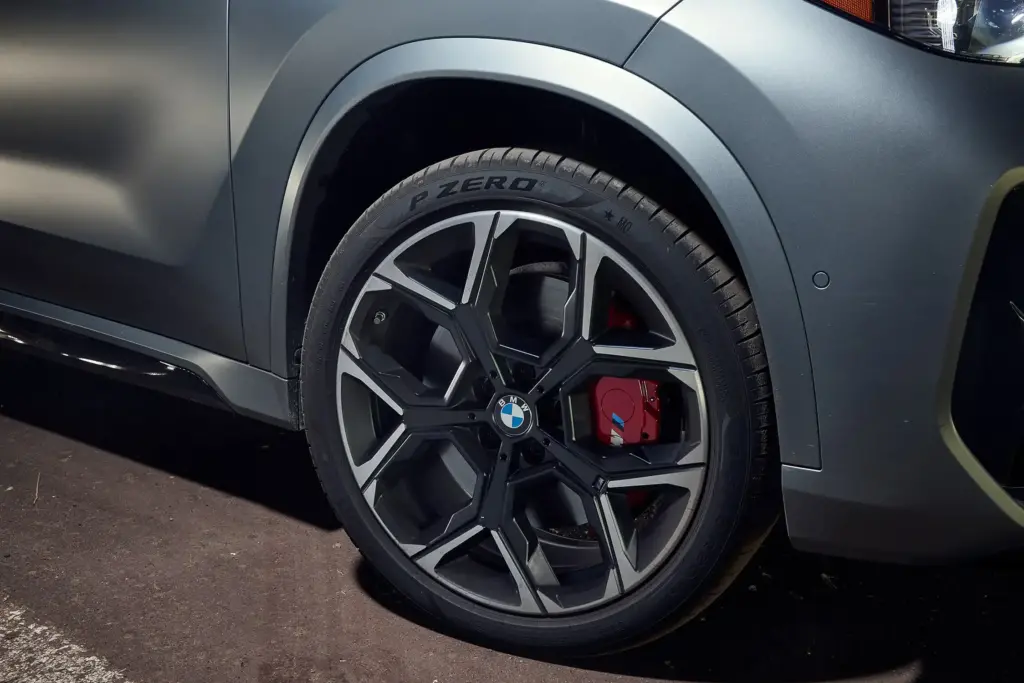
Key Takeaways
- The 2025 X1 adds heated seats, wireless charging, Wi-Fi hotspot standard across both trims enhancing value proposition.
- Base xDrive28i recommended over M35i saving $10,000+ while delivering sufficient 241 HP for daily needs.
- 28 MPG combined beats Audi Q3’s 24 MPG reducing long-term fuel costs by approximately $300-500 annually.
- Third-generation reliability data limited though electronic issues including infotainment freezing and auto start-stop problems reported by some owners.
- 57.2 cubic feet cargo beats Audi Q3 though falls short of Mercedes GLB’s class-leading space considerations.
- Car and Driver “Editors’ Choice” winner praised for athletic handling distinguishing from bland compact SUV competitors.
- Extended warranty consideration recommended given electronic complexity potentially causing expensive post-warranty repairs requiring coverage protection.
FAQs
What is the price of the 2025 BMW X1?
How much horsepower does the 2025 BMW X1 have?
What is the fuel economy of the 2025 BMW X1?
Does the 2025 BMW X1 have all-wheel drive?
What’s new for the 2025 BMW X1?
New for 2025: heated front seats now standard, wireless device charging standard, Wi-Fi hotspot with eSIM 5G standard, iDrive 9 operating system update. Four new colors added. No exterior or mechanical changes[1].
Is the 2025 BMW X1 reliable?
Third-generation (2023+) reliability data limited with mixed owner reviews. Some report excellent reliability while others experience electronic issues including infotainment freezing and auto start-stop problems. Four-year/50,000-mile warranty provides coverage. Extended warranty recommended[5][7].
How does the BMW X1 compare to Audi Q3?
What is the cargo space in the 2025 BMW X1?
Does the 2025 BMW X1 have a third row?
No, the 2025 X1 accommodates only five passengers in two rows. No third-row seating available regardless of trim level. Buyers requiring seven-passenger capacity should consider Mercedes-Benz GLB offering optional third row[2].
What are common problems with the 2025 BMW X1?
Is the BMW X1 M35i worth the extra cost?
Most reviewers say no. Car and Driver notes M35i “too high-strung for everyday driving” with firmer ride compromising comfort. Base xDrive28i’s 241 HP sufficient for daily needs while saving $10,000+. M35i justified only for dedicated performance enthusiasts[2].
References
- Car and Driver. (2024). 2025 BMW X1 Review, Pricing, and Specs. https://www.caranddriver.com/bmw/x1
- Century BMW. (2024). 2025 BMW X1 Review | Specs & Features | Greenville SC. https://www.century-bmw.com/2025-bmw-x1-specs-features-model-review-greenville-sc.htm
- Cars.com. (2024). 2025 BMW X1 xDrive28i specs & colors. https://www.cars.com/research/bmw-x1-2025/specs/
- Audi 3 Rivieres. (2025). 2025 BMW X1 vs. Audi Q3: A Comparison. https://www.audi3rivieres.com/blog/2025/june/16/bmw-x1-versus-audi-q3-differences.htm
- Edmunds. (2025). 2025 BMW X1 Consumer Reviews – 37 Car Reviews. https://www.edmunds.com/bmw/x1/2025/consumer-reviews/
- Auto Safety. (2025). 2025 BMW X1 Recalls, Complaints and Investigations. https://www.autosafety.org/vehicle-safety-check/2025-bmw-x1/
- Capital Motor Cars. (2024). BMW X1 Reliability: Performance and Durability Review. https://capitalmotorcars.com/bmw-x1-reliability-performance-durability-review/
- YouTube. (2025). Audi Q3 vs BMW X1 – Which Compact SUV Dominates 2025? https://www.youtube.com/watch?v=T_F7CQOlPoQ

I am a senior automotive analyst at Autvex. Expert vehicle evaluations, in-depth reviews, and objective analysis helping readers make informed automotive decisions with years of industry experience.

